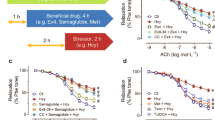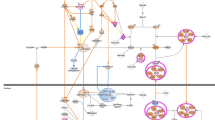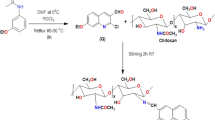Abstract
Aim:
To investigate the effects of a traditional Chinese medicine formula Qing Huo Yi Hao (QHYH) and its components on hydroxyl radical (HO•) production in vitro and the activity of QHYH against free radicals in cultured endothelial cells induced by high glucose.
Methods:
Hydroxyl radicals (HO•) were generated through Fenton reactions in vitro, and 5,5-dimethyl-1-pyrroline N-oxide (DMPO) was used as a spin trap to form DMPO/HO• adducts detected using electron paramagnetic resonance (EPR). Immortalized mouse cerebral microvascular endothelial (bEnd.3) cells were treated with high glucose (35 mmol/L). The free radical scavenging ability of QHYH in the cells was evaluated using EPR. Superoxide dismutase (SOD) was used to identify the free radicals scavenged by QHYH in the cells.
Results:
QHYH and its 8 components concentration-dependently reduced DMPO/HO• signaling. The DMPO/HO• adduct scavenging ability of QHYH was 82.2%, which was higher than each individual component. The free radical scavenging ability of 1% QHYH in high glucose-treated bEnd.3 cells was approximately 70%. In these cells, the free radicals were also specifically reduced by SOD (400 U/mL), implying that the free radicals were primarily superoxide anions.
Conclusion:
The results demonstrate that the QHYH formula is potent antioxidant acting as scavenge of superoxide anions in high glucose-treated endothelial cells.
Similar content being viewed by others
Log in or create a free account to read this content
Gain free access to this article, as well as selected content from this journal and more on nature.com
or
References
Halliwell B, Cross CE . Oxygen-derived species: their relation to human disease and environmental stress. Environ Health Perspect 1994; 102: 5–12.
Halliwell B . Reactive oxygen species in living systems: source, biochemistry, and role in human disease. Am J Med 1991; 91: 14S–22S.
Holmgren A, Johansson C, Berndt C, Lonn ME, Hudemann C, Lillig CH . Thiol redox control via thioredoxin and glutaredoxin systems. Biochem Soc Trans 2005; 33: 1375–7.
Kirkman HN, Gaetani GF . Mammalian catalase: a venerable enzyme with new mysteries. Trends Biochem Sci 2007; 32: 44–50.
Shi M, Yang H, Motley ED, Guo Z . Overexpression of Cu/Zn-superoxide dismutase and/or catalase in mice inhibits aorta smooth muscle cell proliferation. Am J Hypertens 2004; 17: 450–6.
Covarrubias L, Hernandez-Garcia D, Schnabel D, Salas-Vidal E, Castro-Obregon S . Function of reactive oxygen species during animal development: passive or active? Dev Biol 2008; 320: 1–11.
Ridnour LA, Isenberg JS, Espey MG, Thomas DD, Roberts DD, Wink DA . Nitric oxide regulates angiogenesis through a functional switch involving thrombospondin-1. Proc Natl Acad Sci U S A 2005; 102: 13147–52.
Reddy VP, Zhu X, Perry G, Smith MA . Oxidative stress in diabetes and Alzheimer's disease. J Alzheimers Dis 2009; 16: 763–74.
Shenouda SM, Widlansky ME, Chen K, Xu G, Holbrook M, Tabit CE, et al. Altered mitochondrial dynamics contributes to endothelial dysfunction in diabetes mellitus. Circulation 2011; 124: 444–53.
Chrissobolis S, Miller AA, Drummond GR, Kemp-Harper BK, Sobey CG . Oxidative stress and endothelial dysfunction in cerebrovascular disease. Front Biosci 2011; 16: 1733–45.
Vendelbo MH, Nair KS . Mitochondrial longevity pathways. Biochim Biophys Acta 2011; 1813: 634–44.
Bonow RO, Gheorghiade M . The diabetes epidemic: a national and global crisis. Am J Med 2004; 116: 2S–10S.
King H, Aubert RE, Herman WH . Global burden of diabetes, 1995-2025: prevalence, numerical estimates, and projections. Diabetes Care 1998; 21: 1414–31.
Xu J, Zou MH . Molecular insights and therapeutic targets for diabetic endothelial dysfunction. Circulation 2009; 120: 1266–86.
Huang PL . eNOS, metabolic syndrome and cardiovascular disease. Trends Endocrinol Metab 2009; 20: 295–302.
Versari D, Daghini E, Virdis A, Ghiadoni L, Taddei S . Endothelial dysfunction as a target for prevention of cardiovascular disease. Diabetes Care 2009; 32: S314–21.
Giacco F, Brownlee M . Oxidative stress and diabetic complications. Circ Res 2010; 107: 1058–70.
Thomas SR, Witting PK, Drummond GR . Redox control of endothelial function and dysfunction: molecular mechanisms and therapeutic opportunities. Antioxid Redox Signal 2008; 10: 1713–65.
Fearon IM, Faux SP . Oxidative stress and cardiovascular disease: novel tools give (free) radical insight. J Mol Cell Cardiol 2009; 47: 372–81.
Ceriello A . Hypothesis: the “metabolic memory”, the new challenge of diabetes. Diabetes Res Clin Pract 2009; 86: S2–6.
Victor VM, Apostolova N, Herance R, Hernandez-Mijares A, Rocha M . Oxidative stress and mitochondrial dysfunction in atherosclerosis: mitochondria-targeted antioxidants as potential therapy. Curr Med Chem 2009; 16: 4654–67.
Rocha M, Apostolova N, Hernandez-Mijares A, Herance R, Victor VM . Oxidative Stress and Endothelial Dysfunction in Cardiovascular Disease: Mitochondria-Targeted Therapeutics. Curr Med Chem 2010; 15: 3827–41.
Tsioufis C, Dimitriadis K, Antoniadis D, Stefanadis C, Kallikazaros I . Inter-relationships of microalbuminuria with the other surrogates of the atherosclerotic cardiovascular disease in hypertensive subjects. Am J Hypertens 2004; 17: 470–6.
Yu DQ, Li XM, Li X, Teng Y, Zhang JZ, Zhao NQ, et al. Effect and security of traditional Chinese medicine prescription on urine albumin excreting rate of type 2 diabetes. Shanghai Med J 2004; 27: 466–69.
Izuta H, Narahara Y, Shimazawa M, Mishima S, Kondo S, Hara H . 1,1-diphenyl-2-picrylhydrazyl radical scavenging activity of bee products and their constituents determined by ESR. Biol Pharm Bull 2009; 32: 1947–51.
Yu LL, Cheng Z . Application of electron spin resonance (ESR) spectrometry in nutraceutical and food research. Mol Nutr Food Res 2008; 52: 62–78.
Rohn S, Kroh LW . Electron spin resonance — a spectroscopic method for determining the antioxidative activity. Mol Nutr Food Res 2005; 49: 898–907.
Qian H, Nihorimbere V . Antioxidant power of phytochemicals from Psidium guajava leaf. J Zhejiang Univ Sci 2004; 5: 676–83.
Shishodia S, Sethi G, Aggarwal BB . Curcumin: getting back to the roots. Ann N Y Acad Sci 2005; 1056: 206–17.
Marklund S, Marklund G . Involvement of the superoxide anion radical in the autoxidation of pyrogallol and a convenient assay for superoxide dismutase. Eur J Biochem 1974; 47: 469–74.
McCord JM, Fridovich I . Superoxide dismutase. An enzymic function for erythrocuprein (hemocuprein). J Biol Chem 1969; 244: 6049–55.
Quan S, Kaminski PM, Yang L, Morita T, Inaba M, Ikehara S, et al. Heme oxygenase-1 prevents superoxide anion-associated endothelial cell sloughing in diabetic rats. Biochem Biophys Res Commun 2004; 315: 509–16.
Quagliaro L, Piconi L, Assaloni R, Da Ros R, Szabo C, Ceriello A . Primary role of superoxide anion generation in the cascade of events leading to endothelial dysfunction and damage in high glucose treated HUVEC. Nutr Metab Cardiovasc Dis 2007; 17: 257–67.
Kang Y, Hu M, Zhu Y, Gao X, Wang MW . Antioxidative effect of the herbal remedy Qin Huo Yi Hao and its active component tetramethylpyrazine on high glucose-treated endothelial cells. Life Sci 2009; 84: 428–36.
Gao X, Zhao XL, Zhu YH, Li XM, Xu Q, Lin HD, et al. Tetramethylpyrazine protects palmitate-induced oxidative damage and mitochondrial dysfunction in C2C12 myotubes. Life Sci 2011; 88: 803–9.
Acknowledgements
This work was supported by grants from the National Natural Science Foundation of China (No 30871196 to Xin GAO) and the National Basic Research Program of China (No 2011CB504004 to Xin GAO).
The authors thank Xiang-lin SHI and Shi-ming CHEN (The Institute for Nutritional Sciences, Chinese Academy of Sciences, China) for technical assistance.
Author information
Authors and Affiliations
Corresponding author
Rights and permissions
About this article
Cite this article
Xu, Q., Zhang, B., Li, Xm. et al. Traditional Chinese medicine formula Qing Huo Yi Hao as superoxide anion scavenger in high glucose-treated endothelial cells. Acta Pharmacol Sin 33, 496–502 (2012). https://doi.org/10.1038/aps.2011.191
Received:
Accepted:
Published:
Issue date:
DOI: https://doi.org/10.1038/aps.2011.191



